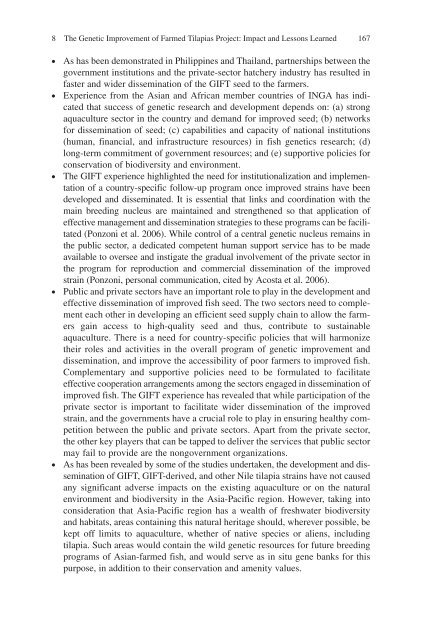Success Stories In Asian Aquaculture - Library - Network of ...
Success Stories In Asian Aquaculture - Library - Network of ...
Success Stories In Asian Aquaculture - Library - Network of ...
- No tags were found...
You also want an ePaper? Increase the reach of your titles
YUMPU automatically turns print PDFs into web optimized ePapers that Google loves.
8 The Genetic Improvement <strong>of</strong> Farmed Tilapias Project: Impact and Lessons Learned167● As has been demonstrated in Philippines and Thailand, partnerships between thegovernment institutions and the private-sector hatchery industry has resulted infaster and wider dissemination <strong>of</strong> the GIFT seed to the farmers.● Experience from the <strong>Asian</strong> and African member countries <strong>of</strong> INGA has indicatedthat success <strong>of</strong> genetic research and development depends on: (a) strongaquaculture sector in the country and demand for improved seed; (b) networksfor dissemination <strong>of</strong> seed; (c) capabilities and capacity <strong>of</strong> national institutions(human, financial, and infrastructure resources) in fish genetics research; (d)long-term commitment <strong>of</strong> government resources; and (e) supportive policies forconservation <strong>of</strong> biodiversity and environment.● The GIFT experience highlighted the need for institutionalization and implementation<strong>of</strong> a country-specific follow-up program once improved strains have beendeveloped and disseminated. It is essential that links and coordination with themain breeding nucleus are maintained and strengthened so that application <strong>of</strong>effective management and dissemination strategies to these programs can be facilitated(Ponzoni et al. 2006) . While control <strong>of</strong> a central genetic nucleus remains inthe public sector, a dedicated competent human support service has to be madeavailable to oversee and instigate the gradual involvement <strong>of</strong> the private sector inthe program for reproduction and commercial dissemination <strong>of</strong> the improvedstrain (Ponzoni, personal communication, cited by Acosta et al. 2006) .● Public and private sectors have an important role to play in the development andeffective dissemination <strong>of</strong> improved fish seed. The two sectors need to complementeach other in developing an efficient seed supply chain to allow the farmersgain access to high-quality seed and thus, contribute to sustainableaquaculture. There is a need for country-specific policies that will harmonizetheir roles and activities in the overall program <strong>of</strong> genetic improvement anddissemination, and improve the accessibility <strong>of</strong> poor farmers to improved fish.Complementary and supportive policies need to be formulated to facilitateeffective cooperation arrangements among the sectors engaged in dissemination <strong>of</strong>improved fish. The GIFT experience has revealed that while participation <strong>of</strong> theprivate sector is important to facilitate wider dissemination <strong>of</strong> the improvedstrain, and the governments have a crucial role to play in ensuring healthy competitionbetween the public and private sectors. Apart from the private sector,the other key players that can be tapped to deliver the services that public sectormay fail to provide are the nongovernment organizations.● As has been revealed by some <strong>of</strong> the studies undertaken, the development and dissemination<strong>of</strong> GIFT, GIFT-derived, and other Nile tilapia strains have not causedany significant adverse impacts on the existing aquaculture or on the naturalenvironment and biodiversity in the Asia-Pacific region. However, taking intoconsideration that Asia-Pacific region has a wealth <strong>of</strong> freshwater biodiversityand habitats, areas containing this natural heritage should, wherever possible, bekept <strong>of</strong>f limits to aquaculture, whether <strong>of</strong> native species or aliens, includingtilapia. Such areas would contain the wild genetic resources for future breedingprograms <strong>of</strong> <strong>Asian</strong>-farmed fish, and would serve as in situ gene banks for thispurpose, in addition to their conservation and amenity values.
















